|
FAQs about Non-Vertebrate Animal Identification
47
Related Articles: Marine Invertebrates, Marine Invertebrate Systems, Marine Invertebrate Compatibility,
Marine Invertebrate Disease,
Marine Invertebrate
Reproduction, Quarantine of Corals and
Invertebrates, Feeding
Reef Invertebrates, Lighting
Marine Invertebrates, Water Flow, How Much
is Enough,
Related FAQs: Non-Vert IDs 1, Non-Vert IDs 2, Non-Vert IDs 3, Non-Vert IDs 4, Non-Vert IDs 5, Non-Vert IDs 6, Non-Vert IDs 7, Non-Vert IDs 8, Non-Vert IDs 9, Non-Vert IDs 10, Non-Vert IDs 11, Non-Vert IDs 12, Non-Vert IDs 13, Non-Vert IDs 14, Non-Vert IDs 15, Non-Vert IDs 16, Non-Vert IDs 17, Non-Vert IDs 18, Non-Vert. ID 19, Non-Vert. ID 20, Non-Vert. ID 21, Non-Vert. ID 22, Non-Vert. ID 23, Non-Vert. ID 25, Non-Vert ID 26, Non-Vert ID 27, Non-Vert ID 28, Non-Vert ID 29, Non-Vert ID 30, Non-Vert ID 31, Non-Vert ID 32, Non-Vert 33, Non-Vert ID 34 Non-Vert ID 35, Non-Vert ID 36, Non-Vert ID 37, Non-Vert ID 38, Non-Vert ID 39, Non-Vert ID 40, Non-Vert ID 41, Non-Vert ID 42, Non-Vert ID 43, Non-Vert ID 44, Non-Vert ID 45, Non-Vert ID 46, Non-Vert ID 47, Non-Vert ID 48, Non-Vert ID 49, Non-Vert ID 50, Non-Vert ID 51, Non-Vert ID 52, Non-Vert ID 53, Non-Vert ID 54, Non-Vert ID 55, Non-Vert ID 56,
Non-Vert ID
57, Non-Vert ID 58,
Non-Vert ID 59,
Non-Vert ID 60, Non-Vert ID 61,
& Marine Invertebrates, Marine Invert.s 2, Marine Invert.s 3, & FAQs about:
Marine Invertebrate Behavior,
Marine Invertebrate
Compatibility, Marine
Invertebrate Selection, Marine
Invertebrate Systems, Feeding
Reef Invertebrates, Marine
Invertebrate Disease, Marine
Invertebrate Reproduction, &
& LR
Life Identification, LR Hitchhiker ID
1, Anemone Identification,
Aiptasia
Identification, Aiptasia ID 2,
Worm Identification, Tubeworm ID, Polychaete Identification, Snail Identification, Marine Crab
Identification, Marine Invert.s 1,
Marine Invert.s 2, Marine Plankton,
|
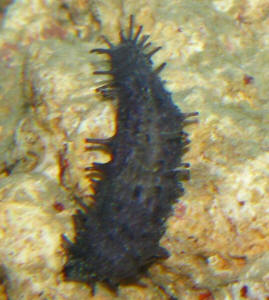 |
|
ID Please: Vermetid Gastropod -- 7/5/09
Good morning!
<Hello Lori, Lynn here today!>
Recently I have noticed this interesting bright orange organism
in my 30 gallon SW reef tank.
<Neat>
It is attached to the inside crevice of my live rock and has a
long tube coming out. I tried to research tube worms, corals and
even sponges, but have located nothing that totally describes
what I am seeing.
<It looks like a Vermetid Gastropod, a sessile, suspension
feeding snail of which there are many species. These are mostly
harmless/beneficial little hitchhikers, although occasionally
they can irritate corals -- especially in high concentrations.
Luckily that doesn't happen very often. For the most part,
they're simply another neat addition to the biodiversity of a
system.>
It seems to extend a sweeper tentacle most of the time, which I
believe is evident in the photo I am sending.
<Yep, it looks like the typical (sticky) mucus strands that
Vermetids use to catch food (planktonic/particulate matter). The
strands are released into the water column, left out for a bit
then reeled back in. Sometimes the strands spread out and appear
more web-like, other times they form what you see in your photos
-- a more cohesive unit comprised of many sticky filaments that
drifts about in the water. As for the color of the tube -- it
varies. I've seen anything ranging from white to dark
brown.>
Sorry for the hermit crab that's in the way.... he just would
not move for a better photo!
<Heee! There's always at least one 'camera hog' in
everyone's tank!>
Any insight on this very intriguing addition to my tank would be
welcomed.
<They are indeed an intriguing addition! For more information,
please see the following links:
http://reefkeeping.com/issues/2005-01/rs/index.php
Google 'Vermetid' at WWM for various faq's re:
http://www.wetwebmedia.com/Googlesearch.htm >
Thanks all!
<You're very welcome!>
Lori in Tampa
|
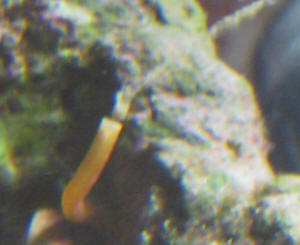 |
|
Something strange~ 6/17/09
Dear Web Media Crew~
<Monica>
I've attached some pictures of something that I discovered
one morning in my 55 gallon salt water with live rock aquarium. I
took a picture to my local fish store and they were unable to
identify what this might be
although they suggested it could be some kind of an egg sac.
<Is my first guess>
It looks almost like some sort of netting with numerous white
specks in it. It is attached to a rock and when completely
stretched out with the flow of the water it measures about 12
inches long and expands to around 7 or 8 inches wide. It stayed
in tact for 2 days and then was gone with no trace of its
existence. My fish didn't bother it nor did they seem to go
out of their way to avoid it. Any thoughts on what this might
have been?
<A reproductive mass of some sort>
Also, any thoughts on controlling the algae on my rock?
<Yes, posted on WWM>
All my readings are good and in the suggested ranges.
<This is not data>
I have used large turbo snails and they clear it initially and
then seem to lose their ambition. I can't have any crabs or
shrimp because of my Huma Trigger.
<I'll bet>
Thank for all that you do~
Monica
<Please use the archives. Bob Fenner>
|
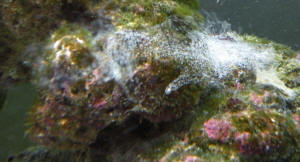 |
Puzzled 5/25/09
Hello,
I am a beginner with a 14 gallon BioCube. I have a couple pieces of
coral, scallop, hermit crabs, snails, and a clown fish. Within the last
couple days I have seen some little things that look like a smaller
version of a bean sprout attached to the glass and rock. What could
that be? Any information would be appreciated.
<My first thought is hydroids, but we really, really need a picture
for this...>
Thank you,
Chris
<Cheers,
Sara M.>
|
Unknown organisms
05/24/09
my name is john and I m from Greece I have a 250liters reef tank
and I wonder what is this market as A and the coral B. The A
think have tentacles and walking crawling up very slowly in two
months about 3-4 cm
<In my opinion A is a sponge... and B is a bleached out
Corallimorph, looks like a Ricordea sp.>
Sorry for my spelling
<No worries. It sounds like you are not a native speaker of
English, so you get a pass. ;-)>
your site is fantastic
<Thank you!>
|
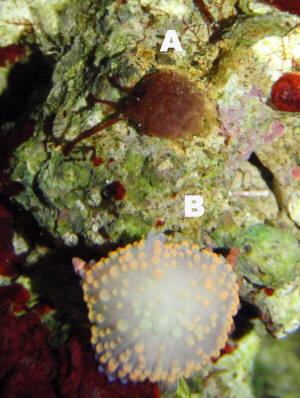 |
Unidentified object in my tank... 05/19/09
<Hello>
This is my first question to you guys at WWM although I have read MANY
of your previous questions and they have helped me avert disasters and
keep from panicking more than a few times...
<Then you are using this service properly and reading before asking
questions. Thank you.>
That said I merely would like to know what I have in my tank that I
have never seen before. My tank is a 30 gallon bowfront tank and my
first attempt at a marine aquarium. It has been up and running for 9
months now and has been doing WONDERFULLY. I purchased a new piece of
live rock this weekend from the LFS and am not sure if that has
anything to do with my new inhabitant. That being said I noticed, this
evening, a spiral shaped object that is sheer with white dots all over
it. The whole object is about 11/2 inches in diameter and the width of
the spiral itself is 2-3 mm. I am attaching a photograph. I was
wondering if it is possibly some sort of egg from one of my tank
inhabitants or something else all together.
<It is hard to see in the photograph,
<<Sara! Where are the graphics? RMF>>
likely not your fault small distant objects tend to be hard to
photograph. The best I can guess from your picture and description is
some type of feather duster. Read here and see if this helps
http://www.wetwebmedia.com/feather.htm .
Tank inhabitants:
2 percula clowns
1 small green dragonet
1 b/w pipefish about 4-5 inches long
1 cleaner shrimp
1 sexy shrimp
1 snail
1 lettuce Nudibranch
aprox 20-25lbs live rock
I also have a soft coral that I bought in the very beginning of my tank
experience...(without research) that has been doing very well and has
been fragging itself all over my tank and I was wondering if you could
tell me if it was a Capnella (photo attached).
<As far as I can tell from the picture I think you did a pretty good
job identifying it. It does look like a tree coral.>
Thank you so much for your help!
<Keep up the good work, and go ahead and send a better picture if
you can get one of the spiral object.
Josh Solomon>
|
Identification Problems - Need Guidance... Scuds,
Myrionema and fish health problems. 5/13/09
Hello WWM Crew!
<Hi Christopher! Mich with you today.>
I've searched through the WWM website for a while now and I
just can't seem to find a positive identification for three
different things/issues I am having with my aquarium.
<Let's see if I can be of help.>
For starters, my 90 gallon aquarium has been established for a
year and a half. All water parameters are within normal ranges
with 0 nitrates/nitrites/phosphates, calcium approx 420, pH
8.2-8.5. I have 2 percula clowns, 1 Firefish, 1 scooter blenny, 1
yellow tang, 1 powder brown tang, 6 green chromis, 1 brittle
star, 1 sandsifter star,
<Not a fan... decimate your sandbed and slowly starve to
death. Best left in the wild in my humble opinion.>
red hermit crabs,
<Not a fan of crabs either... or hermit crabs... Just not to
be trusted.>
common snails, 1 rose bubble-tip anemone (clown host), frogspawn
corals, button polyps, yellow polyps, an beautiful Alveopora,
various mushrooms, a green brain coral, finger leather coral,
disk coral, 2 feather dusters, 2 cleaner shrimp, and a large
decorator crab.
<I'm skeptical with crabs... opportunistic omnivores in my
experience.>
Everything is lit by 150W metal halide lamps and blue actinics. I
have a sump set up below tank with a protein skimmer, filter
pads, and a carbon bag. I do a 10% water change every other
week.
<Good husbandry practices will serve you well.>
The first unidentified problem is with my yellow tang (picture
attached). I can't quite tell what the problem is
<Is difficult to see the damage on the tail section in your
photo.>
- but there seems to be some damage developing along both sides
near the 'nails' by the tail. Almost like erosion.
<I will bounce this to Christine, our resident sick fish
expert.>
The lip of the tang also seems to be wounded and he is constantly
twitching up against the glass on one side of the tank.
<I do see the abrasion on the lip. This could be caused from
the tang rubbing against the glass, or both wounds may be
aggression from tankmates, perhaps the Powder Brown.>
When fed, he eats normally (which is a lot!) and his gills look
okay.
<Good signs.>
I thought maybe HLLE but I really have no idea and this
doesn't quite seem to fit the descriptions.
<Doesn't look like HLLE to me from this photo. I would
recommend supplementing your food with Selcon for the
HUFA's.>
No signs of any problems or damage with my powder brown tang or
any of the other fish.
<This would be my first guess as to where the trouble might be
originating.>
The second is a sort of bug that first appeared in my overflow
tank. There are a bunch of tiny swimmers in there also and they
recently have populated the main section of my tank. These
'bugs' (picture attached) get pretty big but they
don't seem to hurt anything - but I like to get things
identified in my tank and do research just so I know. Any help
with this one would be much appreciated.
<Is a good "bug" is a Gammaridean amphipod also
called a Scud. They are harmless detritivores that make good food
for your tank inhabitants.>
The last is a brown growth that has recently started taking over
my tank like an algae (maybe it is an algae).
<Oh! Bad news here. Is not an algae. Is a hydroid, likely a
Myrionema, and you will need to get rid of it. Not fun!
More similar images here:
http://www.wetwebmedia.com/hyzoidf3.htm>
I looked through my algae book and none of the pictures match
this (picture attached).
<Ya won't find it there!>
It is made up of bunches of tiny stemmed 'fuzzies' that
now and again detach and float somewhere else, where it lands and
a new colony starts!
<Get it out ASAP!!!!>
I'm not sure what I can do about this stuff.
<Manual removal with gloves! Most hydroids can sting, not sure
this variety, but better safe than sorry.>
FEEDING: I feed the tank twice daily. The morning feeding is
always the same - Spectrum color-enhancing pellets, which all of
the fish eat.
<Glad to hear.>
The evening feeding is always frozen food and I rotate between
Spirulina brine shrimp, mysis shrimp, and Emerald Entree.
<Very good.>
I very recently (last week) started supplementing with a Green
Marine Algae with garlic for the tangs.
<Am not familiar with this product.>
As of yesterday, I started supplementing with Marine Snow also,
for the filter feeders.
<Mmm, heard some not so good things about this product.
Cyclopeeze seems to have a better rep.>
ADDITIVES: I add liquid calcium to the tank nightly (as per the
instructions) and I also add Strontium/Molybdenum every 4 days
and Iodide every week.
<And you test the levels for all of these additive, correct?
Because add things in unknown quantities is just as dangerous or
more than having a deficiency.>
Thanks for your help crew!
<Welcome!>
Your site is the best and I always find great answers looking
through all of the pages.
<And there is a lot to look through!>
-Christopher
<Cheers,
Mich>
Re: Identification Problems - Need Guidance
Christine can you take a look? Images are in the emails with
images folder.
|
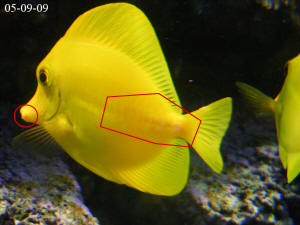 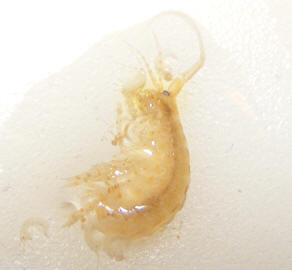 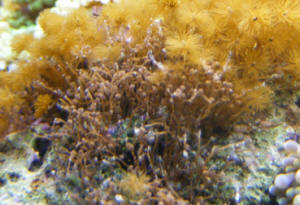 |
|
Hitchhikers: Pistol Shrimp, Brittle Star, Possible
Cowry -- 4/30/09
Hi,
<Hi there, Steve.>
Just wondering if someone can help me ID these critters I found
on my Liverock?
<I'll sure try!>
Just wondering if they are reef-safe or not?
<That term can vary, but I define reef-safe as posing
negligible risk to corals, fish, clams, and most ornamental
shrimps. The first photo is of a Pistol Shrimp -- mostly
reef-safe, reclusive, neat little creatures. I've had them in
my tanks for years with no problems. Second photo is a challenge.
My first impression is that it looks like it might be a Cowry of
some sort with its mantle pulled up and over the shell. Problem
is, I can't quite tell if I'm seeing a hard surface/shell
with protruding tube feet/sensory organs around the perimeter, or
if the whole thing is soft, like some kind of slug. If you could
get me a photo or two of the critter from another angle, fully
submerged, that would be great. Also, what's the size? Does
it feel hard (like there's a shell just under the surface),
or is the whole thing soft? Where did the live rock originate? By
the way, here's a photo of a juvenile Tiger Cowry (Cypraea
tigris) as an example, so you can see how very different these
animals can appear when the mantle is covering the shell:
http://www.sydneyshellclub.net/icon/liveshellsNSW/Cypraea_tigris_Juvenile.jpg
Without the mantle:
http://www.gastropods.com/6/Shell_96.shtml
The third and final photo is of an Ophiuroid/brittle star of some
sort, also reef-safe and beneficial. For more information please
see the following links (as well as those associated links at the
top of each page:
Pistol Shrimps: http://www.wetwebmedia.com/pistolshrimps.htm
Cowries and other Gastropods:
http://www.gastropods.com/6/Shell_96.shtml
Brittle stars: http://www.wetwebmedia.com/brittlestars.htm
Thanks, Steve
<You're very welcome. Take care, LynnZ>
|
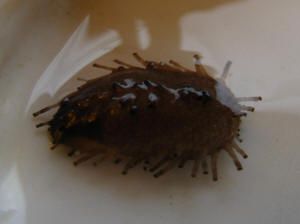
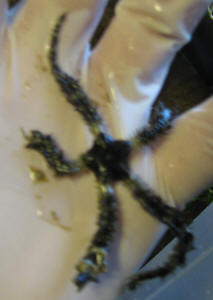 |
Re: Hitchhikers: Pistol Shrimp, Brittle
Star, Possible Cowry -- Nope: Cuke 4/30/09
Hi again,
<Hello Steve, thanks so much for the new photos. Those are
exactly what I needed!>
The little black critter is about an inch long, and it feels
"sort of" soft to the touch. There were 4 of them on the
Irian Jaya Live rock.
<Good, that location fits right in with what I found. Your
little critter is not Cowry at all. It appears to be a common
Dendrochirote Holothuroid/sea cucumber, called Afrocucumis
africana. These are shallow-water Cukes that apparently like to
hang out underneath rocks during the day or within loose rubble,
and supposedly only get up to about 5cm/2' in length. Please
see the following links for more information and a nice selection
of photos for comparison:
http://www.poppe-images.com/images/image_info.php?picid=924831
http://www.poppe-images.com/images/search_results.php?category=Sea%20cucumbers&family=CUCUMARIIDAE
For more information on Cukes of this sort, please see the FAQ
titled 'Anemone Id? Nope, It's A Cuke! 8/10/07' at this
link: http://www.wetwebmedia.com/cukeidfaqs.htm >
I was thinking that the brittle star was the fish eating green
brittle, so I was glad to hear that it is not!!
<Indeed! Although it's difficult to see much detail in the
original photo, the central disk of Ophiarachna incrassata (aka the
green brittle star or 'green death') tends to be less
star-shaped and a bit more round. See the photo at this link for
comparison:
http://www.poppe-images.com/images/image_info.php?picid=900461 and
refer to WWM for care related issues re. >
Thanks so much for your help!
Steve
<It was a pleasure, Steve. Take care, LynnZ> |
 |
|
|

